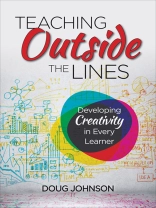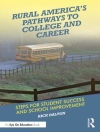Make Creativity The Core Of The Curriculum!
Ignoring creativity is a crisis-in-waiting. But in today’s economy, the ability to think independently and innovatively is no longer a ‘nice extra’—it’s a survival skill.
This book addresses the difficulties of integrating real creativity into the curriculum, and delivers surefire strategies for equipping learners across all grades and subjects with the motivation and critical thinking skills to thrive in a high-tech future.
Content includes:
- Why ‘one right answer’ instruction paradigms discourage critical thinking and risk-taking
- Why using the latest technology does not equate to teaching creatively
- Projects and Prompts that ask ‘So what does this mean in the classroom today?’
Don’t wait another day to begin teaching your students this valuable skill. With this book, you’ll turn your classroom into a hotbed of creativity populated by tomorrow’s innovators.
‘Classroom creativity is essential for lifelong success, and the author develops a compelling argument to teaching students how to do more than respond to standardized test questions. Appropriate for team discussions at every school level and even for parent groups, this book can be used to increase student performance and give students the skills they will use all their lives.’
—Christopher Wells, Educational and Instructional Technology Consultant
Bright Scribe, Inc.
?
‘Johnson offers a succinct, incisive look at fostering creativity in the classroom. He nimbly weaves the value of inspiring creativity with the necessity of teaching craftsmanship (content knowledge, skills, and practice). With well-researched reasoning, practical examples, and insightful questions, Johnson engages readers in thoughtful reflection about educational purpose and methodology.’
—Debbie Silver, Author of Deliberate Optimism: Reclaiming the Joy in Education
विषयसूची
Introduction: How Did Vasco da Gama Spark My Interest in Creativity?
Chapter 1. The Rise of the Creative Class(room): Why Is Creativity No Longer a “Nice Extra” in Education?
Chapter 2. I Can’t Define It, But I Know It When I See It: What Is Creativity Anyway?
Chapter 3. The One-Right-Answer Testing Mentality: Why Are Schools Failing to Produce Creative Graduates?
Chapter 4. The Chupacabra Ate My Homework: What Is the Theory of Multiple Creative Abilities?
Chapter 5. A Job Not Worth Doing Is Not Worth Doing Well: What Are the Attributes of Projects That Help Instill Creativity?
Chapter 6. List Three Right Answers: What Are Some Simple Ways Teachers Can Promote Creative Thinking Every Day?
Chapter 7. Just Because It’s Pretty Doesn’t Mean It’s Original: Does Technology Enhance or Diminish Creativity?
Chapter 8. Not Everything That Counts Can Be Measured: Can—or Should—Teachers Assess Creativity?
Chapter 9. I Stole the Idea From the Internet: How Can Educators Become More Professionally Creative?
Chapter 10. Change Is Good . . . You Go First: Why Do We Love Creativity but Fear Creative People?
लेखक के बारे में
Doug Johnson is the Director of Technology for the Burnsville-Eagan-Savage (MN) Public Schools and has served as an adjunct faculty member of Minnesota State University. His teaching experience has included work in grades K-12 both here and in Saudi Arabia. He is the author of nine books including Learning Right From Wrong in the Digital Age; Machines are the Easy Part; People are the Hard Part; and The Classroom Teacher′s Technology Survival Guide. His columns appear in ASCD’s Educational Leadership and in Library Media Connection. Doug’s Blue Skunk Blogaverages over 50, 000 visits a month, and his articles have appeared in over forty books and periodicals. Doug has conducted workshops and given presentations for over 200 organizations throughout the United States and internationally and has held a variety of leadership positions in state and national organizations, including ISTE and AASL.












